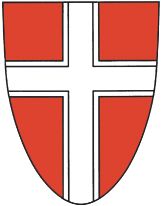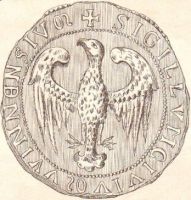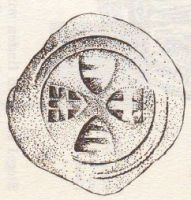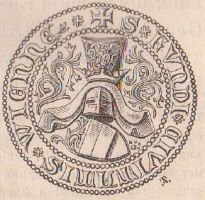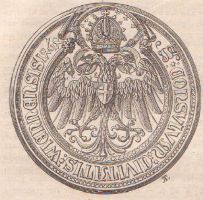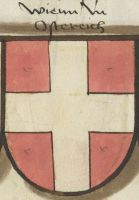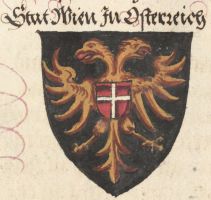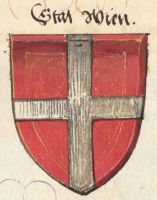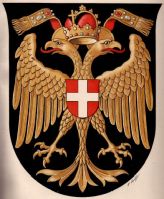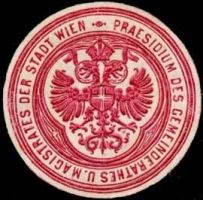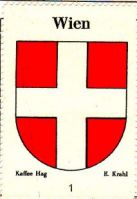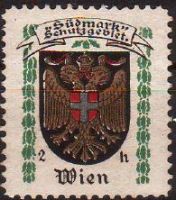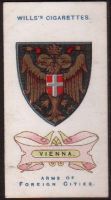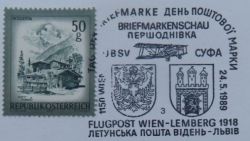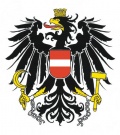Wien: Difference between revisions
Knorrepoes (talk | contribs) |
Knorrepoes (talk | contribs) |
||
| Line 56: | Line 56: | ||
File:wien-k.sum.jpg|alt=Wappen von Wien/Arms (crest) of Wien|The arms on a cinderella stamp | File:wien-k.sum.jpg|alt=Wappen von Wien/Arms (crest) of Wien|The arms on a cinderella stamp | ||
File:vienna.wfc.jpg|alt=Wappen von Wien/Arms (crest) of Wien|The arms on an English cigarette card | File:vienna.wfc.jpg|alt=Wappen von Wien/Arms (crest) of Wien|The arms on an English cigarette card | ||
File:wienp1.jpg|alt=Wappen von Wien/Arms (crest) of Wien|Postal cancellation (with [[Lviv]]) | |||
</gallery> | </gallery> | ||
Latest revision as of 06:00, 10 September 2024
|
(Vienna) Country : Austria State : Wien |
| German | In Rot ein silbernes Kreuz. |
| English | Gules, a cross Argent. |
Origin/meaning
The history of the arms of Wien is long and complicated. The oldest seals of the city show only an eagle. The eagle is most likely derived from the arms of the Dukes of Austria of the Babenberg dynasty. The oldest seal of the city hangs on a document from 1228, but the only remaining document is a copy of unknown date. It its thus not sure whether the city already in 1228 actually used this seal. The oldest original seal hangs on a document from 1239. Another hangs on a document from 1281. The city used smaller (contra- and secret-) seals with the eagle well into the 16th century.
At the end of the 13th century the city also used already the arms with a cross, but not on its seals. A coin issued in 1278 shows 4 shields with the cross. The cross itself is probably a reference to the crusades, to which the people of Wien also participated. It may also simply be a symbol of religion in general. The colour of the cross, silver in red, is known from a book from 1395 and has not changed since.
The Dukes of Babenberg joined the crusades and fought on the battle of Acco in 1191. According to legend, Duke Leopold was the first to scale the walls of the city, with his white tunic completely covered in blood, except for under his belt. The silver bend on red thus became the arms of Austria. The city used seals with the Austrian arms from 1360 until the 17th century, but only to seal documents dealing with the transfer of land. This probably indicated that the land was a possession of the Dukes of Austria and the city acted as its representative.
The first combination of the arms with the cross and the eagle appeared on a seal from 1327. This seal was used during the whole 14th century in different variants, see examples below.
On September 26, 1461 Emperor Friedrich IV granted the city the use of the imperial double headed eagle and Imperial crown. The shield with the cross was not mentioned. The eagle was, for political reasons, not described as the Imperial eagle, but as just a double-headed eagle. As in 1463 the city was lost for the Emperor during the war of succession in Austria, the Emperor retracted all privileges to the city, including the arms granted two years earlier. All rights of the city were transferred to the city of Krems-Stein, which still uses the arms.
After the privileges were lost, the city made peace again with the emperor in 1465 and showed on its seal the double eagle with the cross on its breast. Whether these arms were officially granted, or simply assumed by the city is not known.
The arms with the eagle and cross in a single shield have been used until 1925. The shape of the eagle, the presence of the crown and other smaller details have differed widely during the centuries, but the basic composition remained the same. In many cases the cross appeared without the eagle as arms of the city as well, but on the official seals the eagle was always present.
After the end of the Empire in 1918 the country abolished the double-headed eagle as the symbol of the Emperors, but the city did not immediately follow. In 1925 the city council debated on the use of the old arms and finally in February the council decided that the official arms of the city of Wien were a silver cross in red. In an additional decision it was stated that the arms could be placed on a single-headed eagle. In 1934, the new commisionner of the city of Wien issued a new law, stating two official arms for the city; the small arms with only the cross, and the large arms, which showed again the double eagle, with crown, similar to the arms before 1925. In 1938 the small arms were abolished and now only the arms with the double-eagle were official. In 1945 the city again returned to the arms of 1925, and the arms were now again officially only the cross, but a single-headed eagle can be used as supporter. At present the supporter is not or very rarely used.
Image gallery
The arms in a 16th century manuscript
The arms in the Abadie albums
The arms in the Coffee Hag album +/- 1932
Postal cancellation (with Lviv)
Wiener Bezirke
The city of Vienna is divided into 23 districts or "Bezirke", usually referred to by Roman numerals (Wien I through Wien XXIII) and/or their respective official names, such as "VIII. Josefstadt" The names of the districts derive from formerly independent suburban villages or from former parishes. Each of today's districts is composed of several independent villages or parishes, so with the exception of Wien I and XXIII, all arms are compound arms.
| Composite arms of all villages and parishes in Wien (Ströhl, 1902) |
- Wien I : Innere Stadt are identical of those of the city as a whole
- Wien II : Leopoldstadt
- Wien III : Landstrasse
- Wien IV : Wieden
- Wien V : Margareten
- Wien VI : Mariahilf
- Wien VII : Neubau
- Wien VIII : Josefstadt
- Wien IX : Alsergrund
- Wien X : Favoriten
- Wien XI : Simmering
- Wien XII : Meidling
- Wien XIII : Hietzing
- Wien XIV : Penzing
- Wien XV : Rudolfsheim-Fünfhaus
- Wien XVI : Ottakring
- Wien XVII : Hernals
- Wien XVIII : Währing
- Wien XIX : Döbling
- Wien XX : Brigittenau
- Wien XXI : Floridsdorf
- Wien XXII : Donaustadt
- Wien XXIII
Literature : Lind, 1866; Grenser, 1866; Ströhl, 1902; Coffee Hag album 1930s; Jäger-Sunstenau, 1961; Martinek :'Das Wiener Wappenbuchlein', 1964 ; Diem et al: "Die Wiener Bezirke", Bundesverlag, Wien, 2003
Austria heraldry portal
This page is part of the Austria heraldry portal |
Heraldry of the World |
|
Civic heraldry:
|
Other heraldry: |
Contact and Support
Partners:
Your logo here ?
Contact us
© since 1995, Heraldry of the World, Ralf Hartemink 
Index of the site
